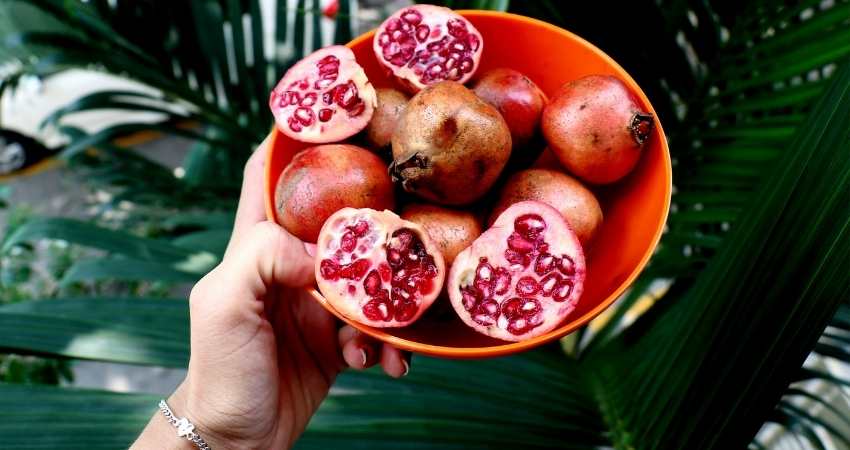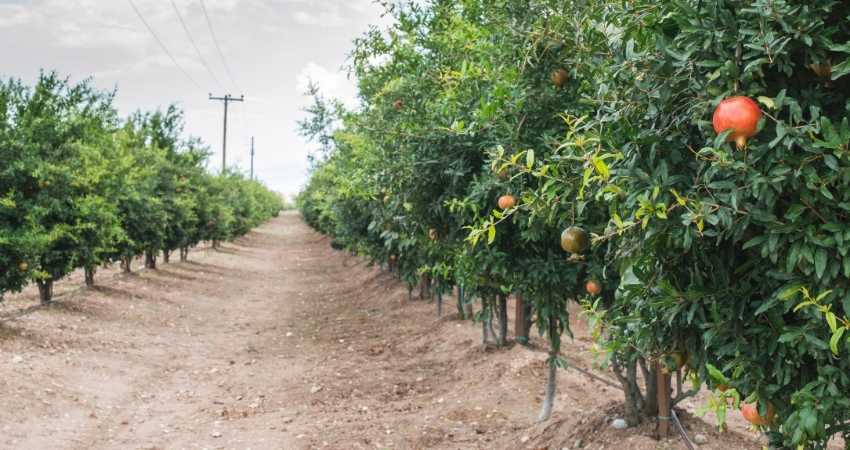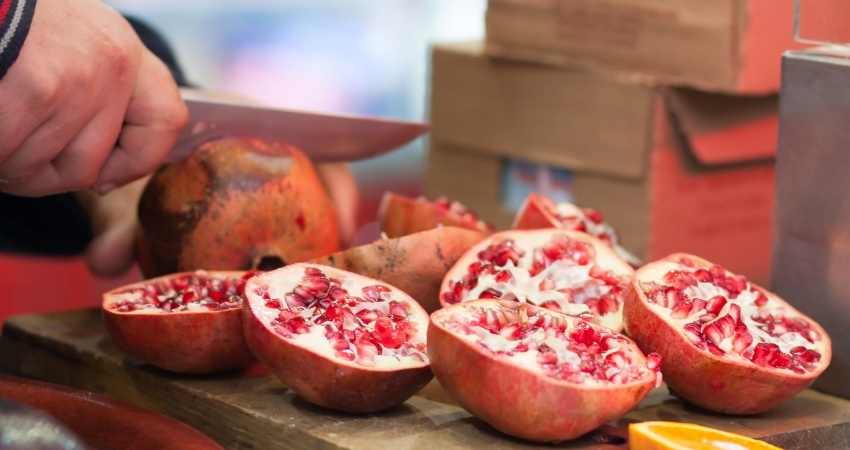Pomegranate Ripe? Here’s How To Tell (And A Few Tips)
Pomegranates are one of those fruits that can be very tricky to determine when they are ripe. The standard methods for checking whether a fruit is ripe don’t necessarily consistently apply to pomegranates. Therefore, how can you tell when a pomegranate is ripe?
A pomegranate is ripe when there is no more green coloring, has a flat angular shape and feels heavy when held. In addition, the skin is leathery, smooth and firm to the touch. Pomegranates will ripen on the tree after 6-7 months.
After reading, you’ll be able to select the ideal ripe pomegranate every time. In addition, I’ve got you covered with how you can store pomegranate and some cool ways in which you can use an overripe pomegranate.
How To Tell if a Pomegranate is Ripe

As a Certified Health Coach many clients ask me about fruit ripeness including pomegranate. Also, I purchase and consume it every week. Therefore, I have researched this topic in the past and present. Let’s examine this topic closely.
The following are five tips for telling when a pomegranate is ripe:
#1: Color
Now, when it comes to the color, this is a little bit harder to judge because pomegranates can vary in color. They can be from light to dark, red, or even pink. A ripe pomegranate should typically be medium to dark red in color with no signs of green anywhere ((Pomegranates: FAQ)).
#2: Shape
Avoid round pomegranates. As pomegranates ripen, the seeds inside exert pressure, thereby causing the pomegranate’s sides to flatten. Therefore, always look for more flat, angular sides as an indicator of a ripe pomegranate.
#3: Weight
When it comes to weight, this is the best method of determining whether a pomegranate is ripe, according to experts from the Pomegranate Council. A ripe pomegranate should feel heavy because it has more juice inside ((Pomegranates: FAQ)).
Great as this tip is, just picking up one pomegranate to determine its weight might not be as easy as it sounds. Just holding one fruit doesn’t give you a frame of reference. So, my advice and bonus tip would be to pick up a few pomegranates to compare.
This can be especially useful if you see some that are round or have some green color, as mentioned to be signs of being unripe. As you compare the weight check for the other signs.
#4: Skin
Smooth, firm, and leathery skin are all good signs of a ripe pomegranate. Don’t be discouraged by scratches or marks on the skin as these are not necessarily signs that the pomegranate is bad or overripe.
#5: Season
Now when it comes to season, this is less of an indicator than any of the other tips that I shared. Fruits that are out of season are simply imported from other countries, thereby guaranteeing availability all-year-round.
Nonetheless, pomegranates are in season in North America around late summer to early winter. Therefore the best time to get ripe ones from your local producers and fruit markets.
How To Pick A Pomegranate
Without sounding misleading, when I use the word pick, I am not referring to another word for choosing or selecting. I am talking about getting the pomegranate fruit off of a pomegranate tree. Once you have followed the tips and determined it is ripe and ready for your enjoyment.
To avoid any damage to the fruit or the tree, pomegranates are not “picked” from the tree. Instead, the stem at the base of the pomegranate fruit is clipped off with the use of pruning shears1.
Make sure to cut the fruit as close as possible to the branch. Once cut, the pomegranate will still have the stem attached to the fruit.

Do Pomegranates Ripen After Picking?
Pomegranates are non-climacteric fruits, which means they stop ripening after they are picked from a tree2. This is the reason why it’s so important to follow the tips laid out at the beginning of this article.
It ensures you pick the pomegranates when they are ripe, rather than too soon or too late. Leaving a pomegranate to ripen on a tree for too long will cause it to split and lose its flavor.
In addition, if you’re buying a pomegranate in the supermarket, it’s more important to pick one at the best ripeness. If you pick one unripe, it’s not going to ripe anymore at home.
How Long Until a Pomegranate Goes Bad? Storing Pomegranates
There are many ways to store pomegranates to keep them fresh and not let them go bad too quickly. Whether it’s the whole fruit or after it has been cut and seeds removed, there are steps you should take.
So let’s briefly look at how and how long you can keep and store pomegranate in different forms before it goes bad.
- Storing whole pomegranates in your house. Whole pomegranates can be stored for a few weeks in a cool, dry place, out of direct sunlight.
- Storing whole pomegranates in your refrigerator. If you want to store it in a refrigerator, it will last for 2 months or even more.
- Storing the seeds in a refrigerator. You can store pomegranate seeds and keep it fresh for about a week or so in a refrigerator.
- Storing seeds in a freezer. Storing pomegranate seeds in a freezer can keep it fresh for around 1 year if frozen in an airtight bag3.
- Storing pomegranate juice in a refrigerator. If you squeeze fresh juice from your pomegranates, you can keep it fresh in a refrigerator for a few days only and should be used within 2-3 days.
- Storing pomegranate juice in a freezer. Freezing your fresh pomegranate juice in a freezer will keep it fresh for longer, but should be used within 6 months.
If you bought pomegranate juice in the supermarket, like POM, the juice will last about 2 weeks after the bottle has been opened. POM is my favorite brand and it’s 100% pomegranate juice.

Check out the chart below for an easier frame of reference. In addition, feel free to download my free chart here, pomegranate storage chart, that you can print out and put up on your fridge for future reference.
| Part | Place | Method | Duration |
| Whole Pomegranate |
In your home | Cool, dry place with no direct sunlight |
2-3 weeks |
| Whole Pomegranate |
Fridge | As normal | 2 months |
| Pomegranate Seeds |
Fridge | In a container | 1 week |
| Pomegranate Seeds |
Freezer | In an airtight bag | 1 year |
| Pomegranate Juice |
Fridge | In a container | 2-3 days |
| Pomegranate Juice |
Freezer | In a sealed bag or container |
6 months |
5 Ways to Use Stored Pomegranates That Become Overripe
If you make use of all the tips on how to tell if a pomegranate is ready, there’ll be times you slightly misjudge it. After cracking it open you may find an overripe pomegranate.
This should not be any cause for alarm or cause a trip to the nearest trash can. I’ve put together five tips on how you can make use of those overripe pomegranates.
The following are 5 ways to use overripe pomegranates:
Juice it
Juicing it will give you all the goodness you were looking for in the first place. The pomegranate juice will go well with many other fruits and ingredients. If you don’t already have any ideas or recipes, there are many on the internet.
Bake it
Muffins, Scones, Cakes, or a vast number of other treats are just a few things that quickly come to mind. They are all a great way to make use of your overripe pomegranate seeds.
Add it to salad
Add some fresh summer flavor to your salads with your overripe pomegranate seeds and enjoy the bursts of pomegranate goodness with every crunchier bite.
Freeze them for smoothies
Another great way to use them instead of being doomed to the trash can is to freeze them to make some yummy pomegranate smoothies. If you plan on keeping them in the freezer for a long period, make sure to refer to our chart for the best way and for how long.
Make pomegranate jelly
You can use the overripe seeds to make some delicious pomegranate jelly.
If you have any questions to ask me about this article don’t hesitate to comment below or email us. You can find an email on our contact page.
Read Next – More Food Storage
A Guide To Pomegranate Juice Storage And Shelf Life
A Guide To Ripening And Storing Strawberries
- Agricultural Marketing Resource Center: Pomegranates [↩]
- UCDAVIS: Pomegranate storage temperature [↩]
- Utah State University: Preserving The Harvest: Pomegranates [↩]
